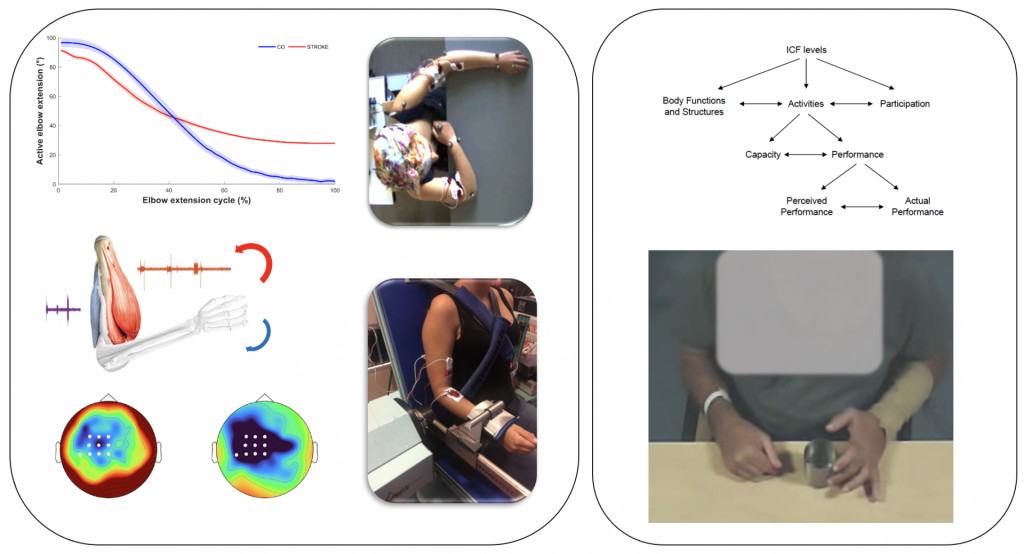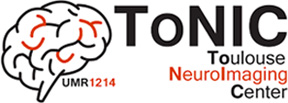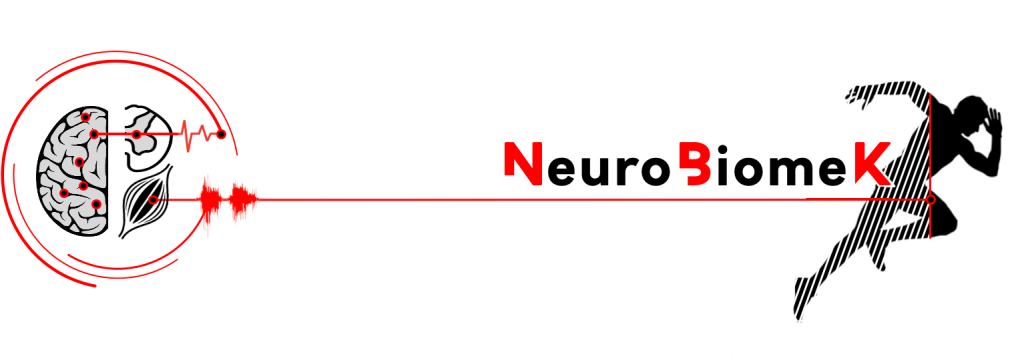Recherche translationnelle en santé,
technologie pour la santé et recherche clinique

Axis 3 : Neurobiomechanics / Topic 3
Multidimensional approach to spastic co-contractions in brain damaged subjects
Physiopathological mechanisms, consequences on upper limb motion alterations and therapeutic implications.
This transactional research theme is focused on the study of the neuromuscular substrates of muscle hyperactivity manifested during movements of the upper limb in brain injured subjects. This expression of muscle hyperactivity corresponds to spastic cocontractions. Through a multimodal approach combining 3D kinematics, electromyography, electroencephalography and anatomical and functional imaging by MRI, the objective is to contribute to a better understanding of the neuromuscular mechanisms involved in this expression of muscular hyperactivity. The impact of spastic co-contractions on movement alterations is also explored, and intramuscular injections of botulinum toxin into overactive muscles are used as an experimental paradigm to study the plasticity of these phenomena.

The better understanding of the impact of spastic co-contractions on movement alterations makes it possible to remove a lock in the development of a prehension neuroprosthesis whose objective is to restore the gripping capacities of the paretic limb after a stroke.
Finally, we contribute to the development of tools for evaluating the factual performance of the upper limb that can be used in ecological situations of everyday life.
Current projects
Multidimensional evaluation of upper limb function in adult with stroke: Analysis of psychometric properties of clinical outcome measures and actual performance assessment – PhD student : Claire VILLEPINTE, Director : Xavier de BOISSEZON, Co-director : David GASQ.
Despite variation, Upper Limb Impairment (ULI) post-stroke typically includes: paresis, somatosensory deficit, as well as abnormal voluntary movement and muscle tone contralateral to brain lesion, defined as hemiparesis. Symptoms post-stroke vary; however neurological impairment leading to loss of arm function and/or reduced arm use is one of the most common deficits post-stroke. Empirical studies estimate 50 to 70 per cent of individuals in acute and 50 per cent in chronic phases have ULI.
ULI has a direct impact upon functional tasks impacting quality of life. Current literature demonstrates strong associations between UL performance level and functional independence contributing to disability and activity limitation.
Due to the multi-faceted nature of UL function and performance, evaluation should be multidimensional including activity and participation limitations, congruent with shifts in clinical practice and research. Present in numerous systematic reviews, the International Classification of Function, Disability and Health framework (ICF) provides a conceptual framework ensuring multidimensional evaluation of UL function. Tendency of the use of combined outcome measure evaluation in relation to the ICF components is strong and findings highlight the consensus that no single measure encapsulates complete UL function. Therefore, grouped measures providing ecological indicators of function will contribute to comprehensive assessment.
There is a lack of validated and standardised outcome measures for the UL post-stroke for use in French physical rehabilitation practice and research-based trials guiding evidence-based practice. Currently, there are no measures that provide assessment of somatosensory capacity of the UL, nor are there established validations of measures of actual performance. This has lead to a lack of standardised administration protocols resulting in variation of scoring among professionals and structures, impacting upon the validity and reliability of assessment post-stroke. The Erasmus modified Nottingham Sensory Assessment (EmNSA) provides a standardised and validated assessment measure of somatosensory capacity post-stroke with potential uses in French practice. Regarding perceived performance, subjective semi-structured questionnaires, such as the Motor Log Activity (MAL) and the Arm Activity Measure (ArmA) provide valuable measures currently implemented to measure rehabilitation methods such as constraint induced therapy and botulinum toxin injection interventions. Current literature demonstrates a multitude of outcome measures of the UL; however systematic reviews demonstrate no clear recommendations exist regarding use of preferred tools. Synthesis of these measures also highlight overlapping of test items and repetition of the testing of ICF components. Comprehensive comparison of measures addressing psychometric qualities and identifying appropriateness for use across different clinical interventions can contribute to identification and selection of suited assessments reducing time and resources in clinical practice. Statistical methods with methods such as Rasch and Guttman analyses will also address repetition of test items and contribute to reduced testing times addressing psychometric qualities appropriate to rehabilitation research.
Clinical characterisation and anatomo-functional neuronal correlates of spastic co-interactions of the upper limb after stroke – PhD student : Camille CORMIER, Director : David GASQ, Co-director : Isabelle LOUBINOUX.
The deficit of active elbow extension, often present in hemiplegic patients, directly impacts grip capacities by altering the approach phase. It is linked to paresis of agonist muscles and spastic hypertonia of antagonist flexor muscles, including the spastic co-contraction. The latter corresponds to a reinforcement of the coactivation of the antagonist muscles present in a physiological manner during voluntary movement. The targets of the treatment of spastic hypertonia by injection of botulinum toxin are often determined by the evaluation of spasticity, while our team has shown that the alterations in movement are more related to the presence of spastic co-contractions than to spasticity.
We wish to study a number of questions with no clear answer in the current literature: the influence of the speed of movement on the intensity of spastic co-contractions and the influence of passive resistance components that may contribute to the impairment of movement. We will also study the anatomo-functional neuronal correlates of spastic co-contractions from anatomical and diffusion MRI images.
For this work, we will use the instrumental and clinical data recorded for the ULISCC-STROKE studies (“Study of spastic co-contractions and limitation of active movements of the upper limb before and after injection of botulinum toxin in routine care in post-stroke patients”; N ° ID-RCB: 2017-A00579-44; Promoter: Toulouse University Hospital; PI: David Gasq) and ULAFBoT-STROKE (“Effects of botulinum toxin and induced neuromuscular plasticity on the facilitation of movements of the upper limb post-stroke ”; ID-RCB N °: 2018-000941-38; Promoter: Toulouse University Hospital; PI: David Gasq).
Neuro-biomechanical study of the central mechanisms of healthy and impaired voluntary motricity control : adaptations to botulinum toxin injections in post-stroke subjects – PhD student : Célia DELCAMP, Director : David AMARANTINI, Co-director : David GASQ.
This multidisciplinary thesis project is located at the crossroads of neurosciences, biomechanics, motor control and signal processing and aims, in a fundamental and clinical double perspective, to contribute to a better understanding of the central nervous mechanisms of control of healthy and impaired motor skills. In an original way, the implication and contribution of the nervous mechanisms of spinal and supraspinal origins will be studied through the analysis of cortico-muscular (CMC) and intermuscular (IMC) coherences, combined with that of cortical oscillatory activity (ERD) in healthy subjects and post-stroke subjects treated with botulinum toxin (BTxA) and rehabilitation.
The central study of this work, for which an ethic agreement has already been obtained (ULAFBOT-Stroke “Effects of botulinum toxin and induced neuromuscular plasticity on the facilitation of movements of the upper limb after stroke”; N ° EudraCT: 2018-000941-38; sponsor: Toulouse University Hospital; PI: David Gasq; start: June 2020) will therefore focus on healthy volunteers (n = 40) and chronic post-stroke patients (n = 40). Since botulinum toxin is widely prescribed in the clinic in order to improve motor function (Welmer et al., 2010), its inhibitory effect will be studied with regard to motor performance during active movements of the upper limbs, on the various biomarkers of the mechanisms that control motor skills in post-stroke patients compared to healthy subjects. The study of the plasticity of the neuromuscular system of patients will be carried out in the short term following an injection of BTxA as well as in the long term after three repeated injections.
From a methodological point of view, this project is based on a particularly relevant approach for studying in depth the mechanisms of human motor control (Boonstra, 2013), which is based on the concomitant study of the following neurophysiological quantities:
i) The cortico-muscular interactions (CMI) quantified between the brain and the muscles, by studying the coherence between the electroencephalographic (EEG) and electromyographic (EMG) signal
ii) Intermuscular interactions, by studying the consistency between two EMG signals
iii) The reactivity of the oscillatory cortical activity (ERD) quantified from the EEG.
Basically, we will compare CMC data with other markers in order to improve our knowledge of its functional role. With the same objective, CMI will be confronted with other intermuscular synergy approaches. An MRI exam performed at the start of the protocol in patients will allow us to characterize the lesions in order to study their impact on the different coherences and on the oscillatory cortical activity and to improve the methodology for quantifying these biomarkers. This original experimental approach will contribute to provide new knowledge on the central mechanisms involved in the control of healthy and pathological movement.
This work also aims at clinical and translational transfer. By shedding light on the understanding of the effects induced by treatment on the control mechanisms of motor skills impaired by stroke, as well as on all structures at the peripheral, spinal and central levels of the neuromuscular system, this study will make it possible to adjust the target and timing of BTxA injections in post-stroke patients.
The team formed has all the materials, technical and technological skills, ethical authorizations and places allowing this project to be carried out under the best conditions, with a level of requirement required under a Doctoral Contract. The candidate’s involvement in the implementation of the protocol already makes her autonomous in carrying out the experiments and all data processing. The excellence of his university career and his research activities attest to his maturity and scientific dynamism. These elements, associated with its ability to already promote her work, are a guarantee of the feasibility and success of this doctoral project.
Design and modeling of intuitive control modalities for an on-board prehension neuroprosthesis for functional replacement after a stroke – PhD student : Ronan LE GUILLOU, Director : Christine AZEVEDO-COSTE (CAMIN INRIA team, Montpellier), Co-director : David GASQ.
Following motor impairments after a stroke, less than 20% of patients use the affected hand in the tasks of daily living. Without a therapeutic solution at the present time, there is a real need for an intuitive grip-assisting neuroprosthesis capable of performing bimanual tasks.
In order to make it possible to use such an on-board device in everyday tasks, intuitive and robust control methods must be developed.
The objective is to design and model control methods using various types of inputs (EEG, EMG, voice, contactor or IMUs for example). These control methods must remain intuitive in order to improve acceptance, be able to be parameterized to facilitate use in real conditions and have robust intention detection to allow functional use in the multiple gripping tasks of daily life. This project is based on the PREHENS-STROKE study (“Evaluation of the functional impact of a self-piloted gripping neuroprosthesis in the hemiparetic patient”; ID-RCB number: 2020-A01660-39; Sponsor: CHU de Toulouse; PI: David Gasq) and on the GRASP-AGAIN project (“Development of an on-board prehension neuroprosthesis to restore gripping capacities in everyday life after a stroke”; Promoter: Toulouse University Hospital; PI: David Gasq).




